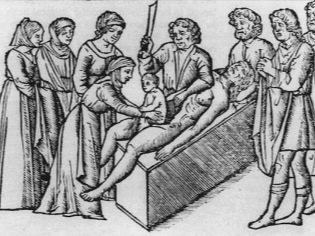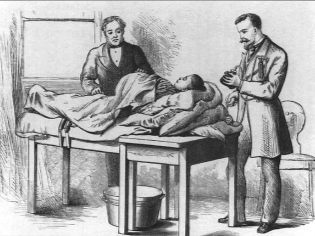Why is “caesarean section” so called?
Regarding the origin of the naming of a cesarean section, there are many different versions. In fact, the history of this name goes far back, and the operation itself is known to mankind from time immemorial.
In this article we will tell some interesting facts about where the name “caesarean section” came from.
Why did they call it that?
If we consider the phrase in terms of direct translation from Latin (the official medical language), we get two words - caesarea "royal" and sectio "incision". The operation was named after Guy Julius Caesar.
Caesar, with his supreme decree, ordered women who had died in childbirth to take the womb, to bring alive babies into the world - the Roman Empire was in dire need of warriors and women who would give birth to them in the future, and therefore every child was important. From this it becomes clear the origin of the concept of "royal cut".
But this is only a term. The operation itself was known before Caesar.
There are data, and ancient Greek myths confirm them, that at the dawn of mankind for the salvation of the child used the dissection of his mother's abdomen. It is possible that Apollo got his son Asclepius out of the womb of the deceased mother, who then became a great healer, known as Aesculapius. There are descriptions of the child’s extraction from the mother’s abdomen and in Chinese ancient parables.
Caesar's decision to legitimize the attempt to save the children of the dead women was justified not only by the needs of the Empire in the warriors, but also by the need to separate the woman and the fetus in the event of death — they were to be buried, for religious reasons, separately.
Roman custom gradually spread to other empires and countries, and a few centuries later became a pretext for sleepless nights and painstaking studies of the luminaries of medicine.
Operation history
Much time passed until the doctors began to guess that the cross section of the womb can be done not only for dead women, but also for the living, who can never be delivered. Only in the 16th century, the court royal doctor, Frenchman Arbroise Pare, first tried to operate on a live woman in labor. The result was deplorable: the woman died.
And the followers of Paray also failed to achieve the survival of women in labor. A total mistake was the inattention to the incision in the uterus. Surgeons applied external sutures, but did not try to stitch the uterus, believing that it should grow together by itself. As a result, all women died.
In 1879, the Italian doctor Edouard Perrot proposed to solve the problem of maternal mortality by the cardinal method of removing the uterus after the baby was removed. Survival increased, every fifth woman managed to survive, but they could not have more children.
After another six years, the doctors guessed that the imposition of individual sutures on the uterus would improve the results of the operation. Since then, the uterus is sewn up. In the XX century, the world learned that such antibiotics, their use after the operation of cesarean section has reduced mortality. Now, such a surgical intervention was started, not only to save the child of the dying mother, but also to save the life of the woman herself.
Today, the share of cesarean section in the total number of all births on the planet is at least 20%. This means that every fifth child is born through surgical care. The technique of operation continues to improve to this day.
There were modern suture materials, self-absorbable surgical sutures that do not need to be removed, new surgical instruments and techniques appeared. This allowed women to give birth through a caesarean section not only one, but more children.
In recent years, gaining popularity is a new method, which is called slow cesarean section. Doctors make a small incision in the lower segment of the uterus, after which the child is born even longer, but almost in a natural way, overcoming a certain resistance. The method is already very popular in Europe. Now, clinics and doctors have also appeared in Russia, who undertake to do a slow cesarean section, but there are not so many of them so far.
On the new "slow" form of cesarean section can be found in the following video.


















